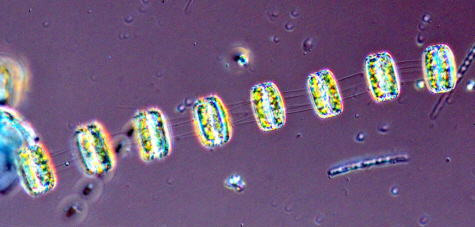


|
Synonym(s)
Heterotypic
A difference in type. In naming species, a heterotypic synonym is one that comes into being when a taxon becomes part of a different taxon. Compare to homotypic.
(heterotypic)Thalassiosira polychorda (Gran) E. Jorgensen 1899 (heterotypic)
Coscinodiscus polychordus Gran 1897 (heterotypic)
Coscinodiscus anguste-lineatus A. Schmidt 1878 Close
Basionym
The original name for an organism. In botany, the original published nomenclature from which a new binomial nomenclature is derived for a particular group of organisms (Tindall 1999).
(basionym, CloseHomotypic
Expressing the same fundamental type or structure; may or may not be symmetrical (e.g., the two valves of a diatom, where they are the same shape and appearance, but one is bigger than the other). In naming species, a homotypic synonym is one that comes into being when a taxon gets a new name (without being added to an already existing taxon).
homotypic)(Guiry and Guiry 2012)
Classification
(Guiry and Guiry 2012)
Lifestyle
Description
Margin
The outline or border that defines the shape of an organism or cell.
margins. Adjacent cells are connected by multiple threads scattered around the CloseValve
In diatoms, the structurally distinct halves of the cell wall (Becker 1996).
valve centre. The valve face is flat or weakly convex, with rounded edges (Cupp 1943). Chloroplasts are numerous, small, and discoid (Kraberg et al. 2010). Cells are yellow-brown in colour (Guiry 2012).Strutted process
(how is this different than marginal process?) In some diatoms, a narrow tube through the frustule that is usually associated with the secretion of chitin. It may appear as a marginal process or as a simple pore in the valve wall (Spaulding et al. 2010).
strutted processes that form a subcentral ring, with one to nine CloseProcess
A natural projection or appendage on an organism.
processes per arc (Hasle and Syvertsen 1997). A marginal ring of strutted processes with distinct external tubes is present; one CloseLabiate process
In diatoms, a simple slit in the valve wall with two internal lips, one on each side of the slit. They can be useful in identification because they are positioned differently in different species (Horner 2002).
labiate process is located slightly inside this ring and midway between two strutted processes (Kraberg et al. 2010).Measurements
Height Close
Pervalvar axis
The axis through the centre point of the two valves of a frustule. This axis is perpendicular to the valve face.
(pervalvar axis): 10 - 40 μmValve Close
Areola(e)
In diatoms, the regularly repeated hexagonal holes on the valve walls (HPP 2003).
areolae: 8 - 18 in 10 μmClose
Marginal process
In some diatoms, a long, coarse external tube through the frustule (Tomas 1997).
Marginal processes: 3 - 6 in 10 μm(Hasle and Syvertsen 1997, Kraberg et al. 2010)
Similar species
Harmful effects
Habitat
Estuary
The area where a river meets the ocean. Often characterized by high sediments, high nutrient levels, salinity fluctuations and tidal mixing.
estuaries (Gayoso 1983).Distribution
Cosmopolitan (Hasle and Syvertsen 1997).
It can be a dominant contributor to spring blooms in Northern European seas (Kraberg et al. 2010), off of NW Russia (Makarevich and Matishov 2000), in the SW Atlantic (Akselman 1996), and near northern Japan (Maita and Odate 1988). It was also found in large numbers during a winter bloom in an estuary near the SW Atlantic (Gayoso 1983).
Occasionally present off southern California, but never in large numbers (Cupp 1943).
Growth conditions
Environmental Ranges
Temperature range (°C): -1.679 - 18.490
Nitrate (μmol L-1): 0.551 - 28.280
Salinity: 17.940 - 36.128
Oxygen (mL L-1): 5.427 - 9.002
Phosphate (μmol L-1): 0.067 - 2.337
Close
Silicic acid
A general term to describe chemical compounds containing silicon, oxygen and hydrogen with a general formula of [SiOx(OH)4-2x]n. Diatoms polymerize silicic acid into biogenic silica to form their frustules (Azam and Chisholm 1976).
Silicate (μmol L-1): 1.705 - 59.039(OBIS 2012, cited in EOL 2012)
Bloom characteristics
References
Akselman, R. 1996. Ecological studies in San Jorge Gulf and adjacent areas (SW Atlantic). Phytoplankton distribution, abundance and seasonal variation in relation to physico-chemical factors and hydrology. Unpublished doctoral thesis, University of Buenos Aires, Argentina.
Cupp, E. E. 1943. Marine Plankton Diatoms of the West Coast of North America. University of California Press. Berkeley, California. 238.
Encyclopedia of Life (EOL). 2012. Thalassiosira anguste-lineata. http://eol.org/pages/915774/overview. Accessed 26 Feb 2012.
Gayoso, A. M. 1983. The phytoplankton of Bahia Blanca estuary; internal part: Puerto Cuatreros. Studia Oecologica. 2(2): 73-88.
Guiry, M. D. 2011. Thalassiosira anguste-lineata (A. Schmidt) G. Fryxell and Hasle, 1977. http://www.marinespecies.org/aphia.php?p=taxdetails&id=148914. Accessed 26 Feb 2011.
Guiry, M. D. and Guiry, G. M. 2012. Thalassiosira anguste-lineata (A. Schmidt) G. Fryxell and Hasle. http://www.algaebase.org/search/species/detail/?species_id=33058. Accessed 26 Feb 2012.
Hasle, G. R. and Syvertsen, E. E. 1997. Marine diatoms. In: Tomas, C. R. (ed.) Identifying Marine Phytoplankton. Academic Press, Inc., San Diego. 5-385.
Kraberg, A., Baumann, M. and Durselen, C. D. 2010. Coastal Phytoplankton: Photo Guide for Northern European Seas. Verlag Dr. Friedrich Pfeil, Munchen, Germany. 204.
Leising, A. W., Pierson, J. J., Halsband-Lenk, C., Horner, R. and Postel, J. 2005. Copepod grazing during spring blooms: Can Pseudocalanus newmani induce trophic cascades? Progress in Oceanography. 67(3-4): 406-421.
Maita, Y. and Odate, T. 1988. Seasonal changes in size-fractionated primary production and nutrient concentrations in the temperate neritic water of Funka Bay, Japan. Journal of the Oceanographical Society of Japan. 44: 268-279.
Makarevich, P. R. and Matishov, D. G. 2000. Spring production cycle of phytoplankton in the Kara Sea. Doklady Biological Sciences. 375: 627-629.
Ocean Biogeographic Information System (OBIS). 2012. Thalassiosira anguste-lineata. http://www.iobis.org/mapper/?taxon_id=761182. Accessed 26 Feb 2012.
Wichard, T., Poulet, S. A., Halsband-Lenk, C., Albaina, A., Harris, R., Liu, D. and Pohnert, G. 2005. Survey of the chemical defence potential of diatoms: Screening of fifty one species for α, β, γ, δ-unsaturated aldehydes. Journal of Chemical Ecology. 31(4): 949-958.
